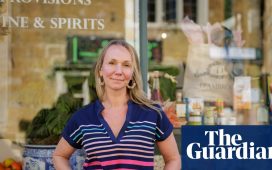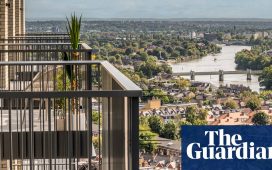Shares in Bank OZK, a mid-sized US lender with century-old roots in rural Arkansas, plummeted 20 per cent in May after a Citigroup analyst questioned its increasing exposure to the troubled commercial real estate sector.
Two weeks later, the bank inked a deal to finance the largest real estate loan in Florida history — $668mn to finish Miami’s Waldorf Astoria, a 100-storey condominium planned as the tallest US skyscraper south of Manhattan. It came as the inventory of high-end Miami condos has risen 40 per cent in the past year amid slowing sales and a glut of new construction.
How a modest community bank that began in the Ozark Mountains, with a thriving business in boat and motorhome lending, became one of the nation’s most willing sources of high-end construction finance is a story of risk-taking in markets where others were reluctant to lend. No lender has had a greater impact on reshaping Miami’s gleaming skyline in the last decade than Bank OZK.
But the story is also one that is now raising alarms: Bank OZK is the most exposed of the top lenders to the notoriously boom-and-bust Florida housing market, with concerns mounting about signature large loans and concentration risk in its portfolio. The bank is scheduled to report second-quarter results on Wednesday.
“About 200 loans comprise more than 50 per cent of their total loan book,” said Benjamin Gerlinger, the Citigroup analyst who wrote the May report, noting its peers tended to issue many more loans in much smaller amounts. “That’s a level of concentration that some regulators would be sceptical of.”
OZK has long attracted sceptics — most notably short seller Carson Block, who in 2016 called the company’s business model “ass backwards” at a popular investing conference. Block’s Muddy Waters Research announced it was shorting OZK stock, citing its rapid push into commercial real estate. Shares dropped 15 per cent on the announcement, but rebounded quickly and finished that year up more than 40 per cent.

Bank executives remain unfazed.
“Real estate concentration is old news for the bank,” said Brannon Hamblen, OZK’s president. “Ours has always been larger than the norm, it’s a bank built predominantly on real estate lending.
“We are here today doing our business the way we’ve always done it.”
Bank of Ozark was founded in 1903 in Jasper, Arkansas, population 547. Its modern iteration began to take shape in 1979, when it was purchased by George Gleason, then a young lawyer at Little Rock’s Rose Law Firm, where Hillary Clinton was a partner.
It began expanding in the 1990s and relocated its headquarters to Little Rock, Arkansas’ state capital and largest city. Over the years the bank rolled up numerous failed regional banks, as well as their deposits, accelerating its move into real estate lending in the process. Its assets have grown from $7bn to $36bn in the past 10 years; in 2018, it rebadged itself as Bank OZK, a change that “frees us from the limitations of a name tied to a specific geographic region”, Gleason, now 71, said at the time.
The OZK name appears on more large deals than any other real estate lender in Miami, the biggest region in its portfolio by dollar value, with more than $4.7bn in 38 loan commitments — representing more than 10 per cent of its loan book.
Some property lawyers estimate OZK has been involved in at least half of the major deals they’ve put together in the past decade, far more than any other lender, and is respected by developers for its ability to navigate complex real estate projects.
Though it competes with sophisticated property funds in a leveraged and risky sector, OZK continues to operate like a traditional regional bank, investing with customer deposits rather than raising debt or syndicating its loans. “Gleason would say, ‘If I believe it’s a loan worth doing then I want all of it,’” said Stephen Scouten, an analyst at Piper Sandler.
The lender has stayed aggressive as other banks have grown more cautious about real estate. Last year, Bank OZK increased its construction lending by $3bn, $1bn more than JPMorgan, the nation’s largest bank, and the most of any bank in the country.

The origin of OZK’s dominance in Miami lies in the ashes of the 2000s US financial crisis, when Florida was the centre of the housing bubble.
Many banks, burnt on construction lending, were not comfortable lending at the scale Miami needed to build. “There was a lot of hesitation,” said Greg Newman, OZK’s senior managing director for lending in Miami.
Because property values in Arkansas never ballooned in the run-up to the financial crisis, they also never collapsed, and OZK remained well capitalised. OZK stepped in to fill the gap.
“Overnight, it became ‘Hey, what do you know about this bank because everyone is asking’,” said Andrew Sharpe, a real estate lawyer at Greenberg Traurig in Miami. “People had no idea where the Ozarks were.”
The timing was fortuitous, putting the bank in place for Miami’s next big boom. Fuelled by stimulus and a New York exodus during the coronavirus pandemic, Miami became one of the hottest housing markets in the US. OZK made its first loan in Miami in 2012. By March 2024 it had originated 110 commercial loans in the city, worth more than $9bn.
So far, OZK’s underwriting practices have helped it avoid long-predicted doom. The bank has been profitable every year for 45 years, and has a rate of loss on its loans of less than 1 per cent, below the industry average. It has also sought to diversify by expanding its lending for pleasure crafts and recreational vehicles.
In Miami, its loan to value — a measure of risk, in which a lower number indicates greater protection — is 43 per cent, compared with an industry-wide average of about 57 per cent. It is predominantly the last lender on any project, which makes it the first to be repaid in a crisis. And developers have adopted the so-called South American model of financing, requiring buyers to deposit up to 50 per cent of the purchase price, providing equity for construction and making it harder for buyers to walk away.
“Lending is a risk business and the risk is the concentration,” Piper Sandler’s Scouten said. “That’s their not-so-secret sauce. That’s how they drive profitability, they do it in a way that other banks are not comfortable with.”
New luxury towers continue to spring up boasting penthouses topping 10,000 sq ft each. Luxury condo prices recently reached a new high of $1.7mn, up 5 per cent from a year ago.
But limits to the region’s growth are beginning to show. Higher interest rates have slowed sales, which peaked two years ago and are now down 50 per cent. At the same time, inventory has soared.
At this year’s slower sales pace, appraisal firm Miller Samuel estimates there are enough available high-end units to satisfy demand for the next year and a half. Brokerage firm Redfin recently said Florida had more rapidly cooling housing markets than any other US state.
The 2023 bank crisis rattled markets and put regional banks on the radar of investors and regulators. Initially, the focus was on lenders, such as Silicon Valley Bank, that had large losses in securities portfolios. But that concern quickly morphed into questions about what other potential losses could be lurking in the books of mid-sized banks. It wasn’t long before investors and regulators landed on commercial real estate as the thing to watch. Commercial real estate exposure was a vital factor in the demise of New York Community Bank this spring.
Analysts have noted one of the concerns about OZK’s real estate concentration is that much of its growth happened at a time when the market was flourishing.
The Citigroup report on OZK questioned the health of two loans on San Diego and Atlanta office buildings, worth more than $1bn, and cited “compounding credit concerns”. Investors shaved more than $800mn off the company’s market value.
“OZK did a fantastic job of growing in a zero interest rate environment, but the new paradigm post-Covid is different,” said Citigroup’s Gerlinger. “When you are in the business of [funding] Miami condo construction, and you are lending $400mn at a time, that’s thousands of RV loans,” he said, using the acronym for motorhomes known as recreational vehicles.
“You need to do 4,000 RV loans to stay in balance for every Miami condo construction loan,” he added. “That’s difficult.”










